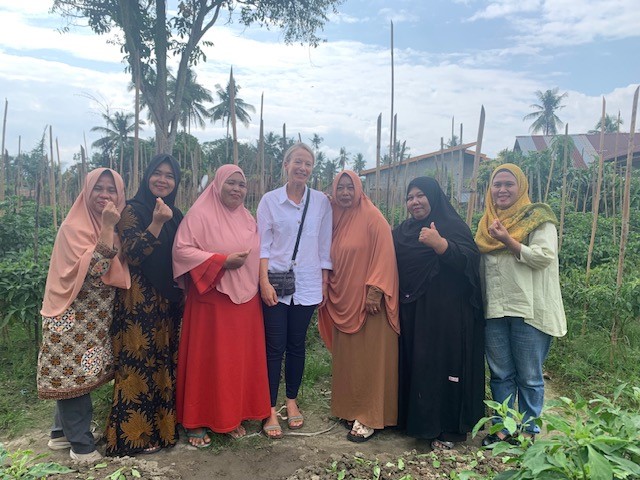Growing Chilis and Communities in Indonesia
by Anna Snider
“We are putting our three kids through university on chili peppers, rice, and cacao!” says Musirah.
I met Musirah and other home gardeners on a recent trip to Indonesia. I was conducting research partnerships to provide extension services to smallholder farmers. The research was funded by a grant from ADM Cares. Musirah and her colleagues were happy to show me their gardens and share their experiences.
Musirah grows chilis, papaya, lettuce, cassava, ginger and turmeric on 0.15 hectares of land around her house in East Luwu, on the island of Sulawesi, Indonesia. Her husband cultivates cacao on some land outside the village. Every five days Musirah harvests 100 kilograms of chilis from her small plot. She sells 80 kg to a trader and the rest her family consumes in dishes such as the spicy sambal sauce found on every table throughout Indonesia.
Musirah is a member of a farmers’ group in her village. Her group benefitted from the Rural Empowerment and Agricultural Development Scaling up Initiative (READSI), a large project co-funded by the International Fund for Agricultural Development and the Government of Indonesia. Every month farmers meet with other members of a group based on their main crop. Home gardening is a popular theme for the women’s groups, as it allows them to provide organic produce for their families, contribute to household expenses, and stay close to home.
“I didn’t garden before [the READSI program] because I had so little land, but I learned about container gardening from the village facilitator,” says one of Musirah’s colleagues in the group. Extension workers provide training on gardening in small spaces and making organic fertilizer from rice water or bamboo leaves. Some group members grow on as little as 0.01 hectares in plastic bags, buckets, and old tires. Not all of the women produce enough to sell, but there is always enough to share with a neighbor in need.
In Indonesia, women are normally the ones who manage the money for the household. They set aside money for savings and for the basic needs of the family. Support for community members is an important way to maintain community ties. The women were happy that their gardens helped them to make small contributions of food or money when there are weddings or other social events in the village. “My husband is happy, too!” one of the ladies adds. Financial literacy is also an important component of the training. While most group members do not keep formal financial records, they have started noting their expenditures after the training.
The gardening group plans to continue producing crops. Expanding production is difficult because they would need more land. More land would also help them to rotate their crops to reduce pest attacks.
I asked the women what it means to be a “good farmer” and they contemplated the question for a while.
“A good farmer is one who provides food to the household and has enough to sell in the market,” answers one.
Another adds, “a farmer who shares with her neighbors.”
Anna Snider is an International Agricultural Development Specialist for AgReach and Associate Director of the ADM Institute for the Prevention of Postharvest Loss.
